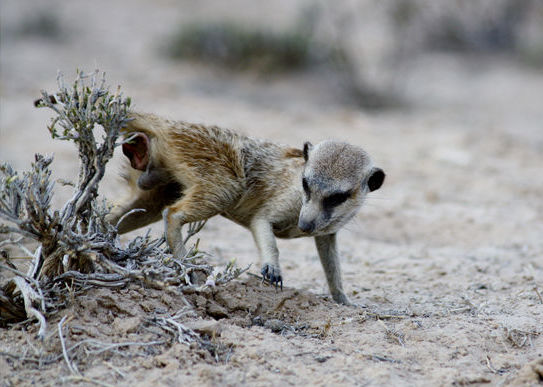Meerkats Can Thank Bacteria for Their Signature Butt Scents
Posted on Categories Discover Magazine

When Disney’s animators were creating Timon, the energetic meerkat sidekick in The Lion King, the part where he turns his anal pouch inside-out and marks his territory must have been left on the cutting room floor. Not once does Timon smear scented butt paste on a branch. But real meerkats use their anal scent glands to communicate with each other. And each animal’s distinctive scent seems to come from its personal community of bacteria.
Both male and female meerkats have anal scent glands. The glands ooze scented liquid out through pores and into a pouch. To mark their habitats with their scents, meerkats turn these pouches inside out (as in the photo above) and rub them on things.
Meerkats can learn a lot from these scent signposts, says Sarah Leclaire of CNRS in France. The scents convey information about an animal’s age, kinship, sex, health, and social status. A meerkat sniffing a marked bush could probably tell which social group the animal who marked it belonged to, Leclaire says.
Previously, Leclaire and her coauthors studied bacterial DNA in meerkat scent. They found communities of bacteria in the paste squeezed straight from the scent glands, as well as in the secretions inside the anal pouch—where, the authors describe appetizingly, scent liquids mix with feces and debris from the environment, such as sand.
Now, to learn more about how these bacteria contribute to meerkat scents, the researchers took a close look at both the chemical makeup of the secretions and the bacterial DNA within them. They gathered scent samples from 37 anesthetized meerkats in a reserve in South Africa.
They first looked for volatile compounds—small molecules that can easily evaporate and be sniffed—in both the pure secretions and the pouches. Inside the pouches, where the secretions were mixed with other gunk, the researchers found more volatile molecules that bacteria had likely produced.
Focusing only on these “mixed” secretions from the pouches, the researchers then found that their chemical makeup was linked to an animal’s sex. Some volatile compounds were more common in male meerkats, and others in females.
Furthermore, they found that each group of meerkats living together had chemically similar smells. “Each individual has a specific scent,” Leclaire says. “However, members of the same group have more similar scent than members of different groups.”
The researchers used DNA sequencing to find out what types of bacteria were living in each meerkat’s anal pouch. They found that the makeup of this microbial community wasn’t random. Males and females had different bacterial communities; so did dominant versus subordinate meerkats. And the bacterial communities varied between meerkat groups, like scent molecules did. So the kinds of information meerkats can glean from each other’s smells—such as what group an individual belongs to—seem tied to bacteria that may help create those scents.
Leclaire says studies like these are becoming more common as technology to sequence DNA advances. And her team’s results fit with other recent studies of the link between microbes and scents. These studies have looked at mice, elephants, and birds called hoopoes. “All suggest that bacteria shape (in part) social scents,” Leclaire says.
In other words, while Timon may have been the sassy sidekick onscreen, real-life meerkats—and other animals—may have their own microscopic sidekicks to thank for their signature smells.
Image: Lydia K. Greene